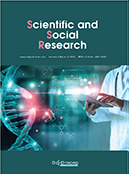Abstract
This article explores the relationship between the evolution of the body view in the era of intelligent media and the body orientation in communication studies. With the development of society and technological progress, traditional body views are constantly changing and influenced by factors such as social culture, technology, and globalization. The advent of intelligent media has provided a new research perspective for communication studies. In the era of intelligent media, the body is not only the object of expression and dissemination but also the carrier of existence and experience in virtual spaces. Meanwhile, the interaction with digital technology has also brought new possibilities to the body. This article presents an analysis of the relationship between the body view in the era of intelligent media and the body orientation in communication studies and in-depth case studies. Finally, this article provides prospects and reflections on future development trends and research directions.
References
Nietzsche F, 1954, The Will to Power, Vintage Books, New York.
Nietzsche F, 1967, The Birth of Tragedy and the Case of Wagner, Vintage Books, New York.
Nietzsche F, 1954, Thus Spoke Zarathustra, Penguin Books, New York.
Han S, 2018, Returning to the Body: Body Landscape and Construction Methods in New Media Space. Chinese Journal of Online Communication Research, 2018(1): 12–15.
Chen Z, Gao R, 2022, The Physical Transmission of Hanfu Culture in the Short Video Era. News Communication, 2022(10): 17–19.
Shen Q, Wang L, 2021, When “Robots” Become Social Actors: Stereotypes in Human-Computer Interaction. Journalism and Communication Research, 2021(2): 37–52.
Zhong Y, 2020, The Body and Media Use of “Internet Celebrities” in Selling Goods in the Consumer Society. News Research Guide, 2020(5): 78–79.
Zhang J, 2020, Visual Symbol Presentation of Consumer Landscape in the New Media Era. News Research Guide, 2020(5): 50–52.
Mohd Said S, Chow CO, Moldatar N, et al., 2011, Accreditation of Engineering Programs: An Evaluation of Current Practices in Malaysia. International Journal of Technology and Design Education, 2011(8): 441–456.
Dreyfus HL, 1991, Being-in-the-World: A Commentary on Heidegger’s Being and Time, Division I, MIT Press, Cambridge.
Crowell SG, 2001, Husserl, Heidegger, and the Space of Meaning: Paths Toward Transcendental Phenomenology, Northwestern University Press, Evanston.
Wrathall MA, 2005, How to Read Heidegger, W.W. Norton & Company, New York.
